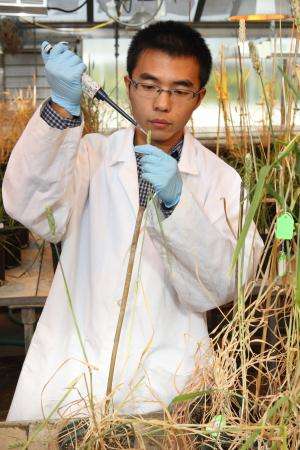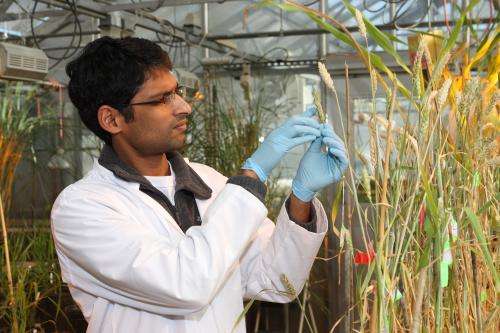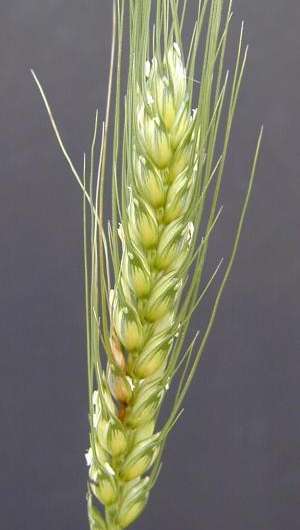Biochemical pathways may be key to scab resistance

Pale, shriveled heads of grain spell trouble for wheat and barley farmers—they're the telltale signs of Fusarium head blight. The fungal disease, commonly known as scab, not only dramatically shrinks yields but it also produces toxins that make the grain unfit for human or animal consumption/
From 1991 to 1996, head blight caused $2.6 billion in losses to the U.S. wheat crop. At its peak, the fungus destroyed the entire malting barley crop in the Red River and Ohio River Valleys, according to professor Yang Yen of biology and microbiology.
Two decades later the U.S. Department of Agriculture still ranks head blight as "the worst plant disease to hit the U.S. since the rust epidemics in the 1950s." Wheat and barley farmers have lost more than $3 billion since 1990 from blight outbreaks.
In 1993, an epidemic of Fusarium head blight caused approximately $80 million in losses for South Dakota spring wheat producers, according to Randy Englund, executive director of the South Dakota Wheat Commission.
Despite major research funding—including the U.S. Wheat and Barley Scab Initiative, scientists admit that efforts to control this devastating disease have met with limited success.
"This is an extraordinary disease that requires extraordinary means to combat it," says Yen, who began working on head blight in 1997.
Using advanced genetic and molecular technologies, Yen has begun tracing the biochemical pathways that make wheat susceptible or resistant to head blight. Three graduate students and two postdoctoral scientists have worked on this research over the last 16 years.
Multiple hosts and pathogens
Head blight can be caused by multiple pathogens, and these pathogens can attack multiple hosts including grasses and corn, Yen explains. This makes the disease tougher to combat.
Graduate student Yinjie Qiu inoculates one wheat kernel with Fusarium graminearum spores.
Researchers are working to develop resistant types of grain, alter tillage practices and apply fungicides to fight the disease.
"This disease is not new," Yen says. It was first reported in England in 1884 and in North America in 1890. Over the last century, serious outbreaks have occurred in Asia, Canada, Europe and South America.
If this disease could be controlled through breeding alone, Yen believes that scientists would have done so by now. Varieties of wheat with some resistance to blight were collected in China during the 1950s and breeding for better resistance has been done since.

The most resistant variety of wheat, Sumai 3, was released in China in the 1960s, Yen explains, "but it still gets the disease."
Fusarium spores exist during winter in the plant debris. Even plowing the stubble under does not eliminate the problem because the fungus also survives in the ground. Wind and rain splash carry the spores onto the head when it flowers, but the weather conditions must be just right—warm, humid and wet—for it to infect the plant.
The wheat flower must be open for the fungus to enter, Yen explains. In susceptible varieties, the fungus kills the infected cells in the head thereby plugging the transport of water and nutrients to the upper part of the head.
While diseases such as stem rust persist on living plant tissues, Yen says, "Fusarium attacks the wheat or barley spikes and the kernels collapse because the fungus kills them and lives on the dead cells."
Sumai 3 successfully delays the development of the disease. Though the kernel on which the spore has landed will be empty, it won't affect the rest of the head, he explains. But this variety has other undesirable characteristics and cannot be used here.
Gene expression
Yen has undertaken a molecular study of the disease, investigating how the fungal infection impacts wheat gene expression. He compared the most resistant varieties of wheat with the most susceptible ones. By looking at how genes were expressed, the molecular biologist narrowed the possibilities from thousands of genes to 608, then to 47 and eventually to three.
"These genes are functional in both resistant and susceptible varieties. How they respond to regulatory pathways triggered by the fungal infection makes the difference" he says.
"That's why normal gene cloning didn't work."
Resistance to the disease is controlled by the chemical pathways of two growth hormones, jasmonate and ethylene, Yen explains. To prove this, he took a susceptible wheat variety, treated it with jasmonate and ethylene and then exposed it to head blight. The wheat plant resisted the fungi.
"Two of the three genes are directly involved in the chemical pathways," Yen explains. "How the third one is involved we still do not know, but it may play a key role because suppressing its function in the first eight to 60 hours after the infection causes the disease development."

Through funding from USDA and the South Dakota Wheat Commission, he has identified biomarkers that will allow breeders to screen for this resistance.
"The discovery and development of true scab resistance in our wheat varieties would not only prevent losses and reduce quality discounts, but also would save farmers millions in dollars of time and investment in treating the disease," says S.D. Wheat Commission Chairman Clint Vanneman."Funding from wheat checkoff dollars for the scientists and continuation of comprehensive integrated wheat research at South Dakota State University is truly a great investment."
Disease development
Essentially, Yen hypothesizes that the fungus softens the host cell wall during infection and triggers a chain of host resistance responses.
"In the resistant wheat, the key resistance gene may delay this chain of reactions until the host tissue is too hard for the disease to develop," Yen explains. "In the susceptible wheat, the disease makes the plant drop this gene expression, so the fungus can get established."
Yen has received a three-year USDA grant for nearly $363,000 to test this hypothesis.
In addition, Yen must find out where the signal is coming from and how the fungus suppresses the gene expression. Only then can the researcher figure out how to prevent the disease from becoming an epidemic.
"Fusarium head blight results from close interaction between the fungus and the host. We need to understand how this interaction is occurring and identify which step is the easiest to manipulate to control the disease," he explains.
That will then allow researchers to determine how to neutralize the fungi's power to infect small grains.
Provided by South Dakota State University

















